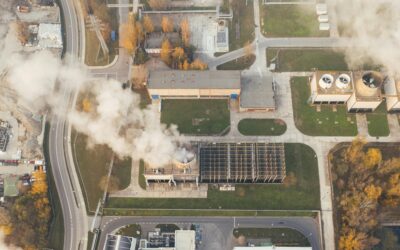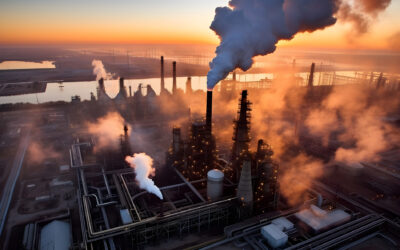Global warming is one of the greatest threats to human society and ecosystems worldwide. While Earth has always experienced changes in global average surface temperatures, the planet is warming at an unnatural rate due to human activity.
We’ll look into what global warming is, what causes it, and some of the evidence that shows global warming is occurring. After that, we’ll discuss how the world can adapt in order to slow global warming from occurring at the rate we are seeing today.
What Is Global Warming in Simple Words?
Global warming describes the long-term increase of Earth’s average temperature. There are natural and human factors that contribute to our warming planet.
Natural factors — like solar cycles, volcanic activity, and changes in Earth’s orbital and rotational patterns — contribute to changes in Earth’s temperature over long periods of time.
Human factors include practices that emit greenhouse gases, like carbon dioxide, nitrous oxide, and methane, which contribute to the greenhouse gas warming effect on our planet.
The greenhouse effect plays the largest role in increasing global temperatures. Greenhouse gases surround the Earth and act as a warming blanket. Heat, in the form of solar energy, enters the atmosphere and cannot escape because the greenhouse gases trap it within Earth’s atmosphere. A larger concentration of greenhouse gases means the planet will warm at a faster rate.
Why Is Global Warming Important?
Global warming is important to understand because it poses a threat to the environmental conditions on Earth as we know them. Increasing global temperatures contribute to global climate change, threaten ecosystems, and create a myriad of issues for humans worldwide.
Global warming drives climate change. So, global warming and climate change are jointly responsible for changes in weather patterns like decreased precipitation, flooding, and more frequent extreme weather events. Other effects of climate change include biodiversity loss, deforestation, and ocean acidification, which affects all marine life.
In the wake of a changing climate, humans are faced with increasing water shortages that reduce access to clean drinking water and limit the potential for food growth. Plus, deteriorating air and water quality threaten public health.
Economic decline is another one of the impacts of climate change, as communities around the world must bear the financial burden of repairing damaged infrastructure after more severe weather events.
What Are the Main Causes of Global Temperature Changes?
Earth has experienced natural global temperature increases in the past, but since the industrial period began, global warming is occurring more quickly due to human activity. Let’s go over the main natural causes of global warming along with the main human causes.
The Natural Causes of Global Temperature Change
Our planet has always experienced natural changes in global temperature. Some of these changes occur frequently and cause a minor shift in the average global temperature. In contrast, others occur over millions or billions of years and are very dramatic changes in temperature.
Below, we’ll look at some of the natural causes of global warming and how much these causes impact temperature change over time.
Solar Cycles
The intensity of the sun’s energy fluctuates. Periodically, the sun dims and causes minor periods of cooling on Earth. The sun can then brighten and cause minor warming. These changes occur over the course of centuries and have a very small impact on Earth’s temperature.
The changes in Earth’s temperature only range between 0.1 to 0.3 degrees Celsius. The sun has slowly been cooling for the last 50 years, so solar temperatures are not to blame for the current global warming we are experiencing.
Volcanic Activity
Volcanic activity can cool and warm the planet. Sulfuric acid emitted from volcanoes during an eruption can block the sun from entering Earth’s atmosphere and cause cooling. On the other hand, Earth can experience warming caused by carbon dioxide emitted from volcanoes.
Sulfuric acid in the atmosphere can cause cooling for anywhere between one and 20 years, depending on the magnitude of the eruption. Sulfur from volcanoes can cool the Earth as much as 2 degrees Celsius.
While volcanoes emit some of the carbon dioxide responsible for global warming, they emit much less than is emitted due to human activity. Each year, humans are responsible for emitting 100 times more carbon than volcanoes do.
Changes to Earth’s Orbit
The Earth has a natural wobble as it rotates and orbits the sun. These cycles change the amount of solar energy that reaches Earth’s surfaces, causing periods of warming or cooling.
In the last 100,000 years, Earth’s temperature has changed about 6 degrees Celsius. The temperature changes have varied throughout geological time, and these cyclical orbital changes occur over thousands to millions of years.
The Human Causes of Global Warming
While Earth naturally experiences changes in global temperatures, it is only recently that humans have started to contribute to the dramatic changes in global temperature we are seeing today. The primary cause for these changes is human activities that emit greenhouse gases.
Below are the primary activities that release harmful greenhouse gases into the atmosphere.
Burning Fossil Fuels
Each year, burning fossil fuels emits about 33 billion tonnes of carbon dioxide globally. Of that amount, coal emits 44%, oil emits 34%, and natural gas is responsible for the remaining 21%.
Burning the fuel used in cars, trains, planes, and ocean vessels emits large amounts of carbon dioxide. Transportation is responsible for emitting the most greenhouse gases each year; in the United States in 2020, the transportation sector emitted 27% of all greenhouse gases.
Electricity generation is another culprit for greenhouse gas emissions, with much of the world reliant upon burning coal for energy. Electricity generation emits the second-largest amount of greenhouse gases in the United States. In 2020, 25% of the country’s emissions came from generating power.
Deforestation
Deforestation and other land-use changes increase the concentration of carbon dioxide in the atmosphere. The trees in forests store large amounts of carbon dioxide. When these trees are cut down for agricultural reasons, urban development, or timber usage, this carbon is released into the atmosphere as the trees decompose.
What is more, the less forest land that exists means there are fewer trees to absorb carbon dioxide from the atmosphere. Forests have been cut down for thousands of years. As a result, around one-third of the world’s forests have been lost, primarily to be replaced with agricultural lands.
Fortunately, deforestation rates have declined since their peak of losing 150 million hectares in the 1980s. In the 1990s, the world lost 78 million hectares of forest land, then dropped down to a loss of 52 million hectares in the 2000s, and 47 million hectares in the 2010s.
While the loss of forest land is declining, it is important to work toward preserving these lands moving into the future to limit the amount of carbon that is released due to deforestation.
Livestock Farming
Raising livestock is responsible for emitting 14.5% of global greenhouse gas emissions. Cattle are the main culprit for greenhouse gas emissions, primarily in the form of methane that is released as part of their digestive process. Methane has a much greater warming effect than carbon dioxide, though it does not last as long in the atmosphere.
The solution to reducing emissions caused by livestock farming is for the world to transition to primarily plant-based diets. Moving away from animal products will reduce the amount of livestock reared each year and, in turn, lower the emissions caused by this industry.
What Are Examples of Global Warming?
Vital signs of global warming can be seen around the world. Below is a list of the impacts of global warming that show Earth’s temperature is increasing:
- Rising temperatures: Earth’s average air temperature has increased by 1 degree Celsius (1.8 degrees Fahrenheit) since 1900.
- Limited snowpack: Longer summers and shorter winters mean snow levels in the mountains are low, posing a threat to water resources in many regions.
- Melting permafrost, glaciers, and ice sheets: Warming temperatures have caused permafrost, glaciers, and arctic sea ice to melt.
- Sea level rise: Sea levels have risen 8-9 inches since 1880, threatening coastal communities with regular flooding and land loss.
- Ocean temperatures rising: The surface of the ocean has risen 0.14 degrees Fahrenheit every decade since 1901.
- Increasing air pollution: Air quality is declining due to increasing heat waves around the world that cause stagnant air in regions.
Will Global Warming Cause Extinction?
Global warming has the potential to cause mass extinction if the planet continues to warm at its current rate. In fact, a study found that we are nearing a sixth mass extinction, one that could see three-quarters of all animal species go extinct in the next 300 years.
Increasing global average temperatures have placed a strain on many animals around the world. Global warming and climate change have caused habitat loss and changes to environmental conditions that many species are struggling to cope with.
How Can We Minimize Global Warming?
In order to prevent global warming from continuing, humanity must come together to change our practices for a more sustainable future on Earth.
The primary driving factor of global warming is greenhouse gas emissions, so in order to prevent further warming from occurring, we all must do our part in emissions reductions. Aiming to meet the goals outlined in the Paris Agreement and returning Earth’s greenhouse gas concentrations to pre-industrial level can help us slow the warming of our planet.
From a large-scale perspective, the world must make a transition to clean energy. Our energy dependence on fossil fuels is a significant contributor to increasing carbon dioxide levels in the atmosphere. Transitioning to solar, wind power, and hydropower are the best options moving forward. Switching to vehicles that operate on electricity rather than fossil fuels is another way to reduce emissions.
Our society must also transition to a diet that is focused more on plants than on beef. Plant-based agriculture is much more sustainable than rearing livestock.
It’s not only large-scale global switches that matter, though. Each individual can take climate action every day. You can do your part to conserve energy in your home by switching to energy-efficient appliances, limiting the amount of power you use each day, and switching to a fuel-efficient vehicle.
Another excellent option for joining the fight against global warming is to participate in carbon offsetting. Carbon offsetting programs allow you to reduce the impact of your carbon emissions by supporting sustainability projects that reduce carbon levels in the atmosphere.
Time to Make a Change and Fight Global Warming
While Earth’s climate and temperature change naturally over long periods of time, the rate at which it is occurring today is alarming. As more carbon dioxide and other greenhouse gases fill the atmosphere, our planet’s temperature will continue to rise. The natural cycles that cause global warming and cooling are not responsible for the temperature increases we see today, so human activity is to blame.
Humans must take action to change our practices. Switching to more sustainable practices is our best bet for reducing greenhouse gas concentrations and allowing Earth’s temperature to regulate itself.
Learn more about Terrapass’ global warming solutions.
Brought to you by terrapass.com
Featured image:











